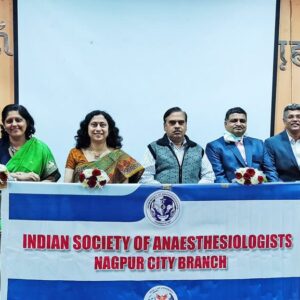
FAQs
Anaesthesia is a speciality branch in medical science. This branch is mainly involved in smooth conduct of all types of surgeries/operations & various procedures being performed by making individuals comfortable, pain-free and unconscious as needed.
Whenever an individual undergoes any type of procedure or surgery that person is likely to feel pain or discomfort. Anaesthesia is needed to abolish the pain, minimise the discomfort and relieve the anxiety.
In India, only clinicians who are legally trained in various aspects of anaesthesia required for that particular procedure can administer the anaesthesia.
In India, anaesthesiology is a speciality of post-graduate training programme conducted by various universities. The basic qualification for applying to the post-graduate course in anaesthesiology is graduation in M.B.B.S. Post-graduate courses include master’s degree (M.D.), diploma (D.A.) and Diplomat of National Board (D.N.B.). While Diploma is two years training programme, minimum three years training is mandatory for M.D. and D.N.B. courses. An anaesthesiologist can have further superspecialisation (D.M) or D.N.B. in specific field like cardiac anaesthesia, Neuroanaesthesia or critical care. Also there are many post qualification certificate courses in different fields of anaesthesiology.
Ideally all persons requiring anaesthesia should be examined clinically and his/her clinical status be optimised to acceptable condition before scheduling for any procedure. This helps to minimise complications arising out of anaesthesia or the procedure itself and thereby chances of morbidities and mortality are decreased. This is called as Pre-Anaesthesia Check-up (PAC).
No anaesthesia is minor. Though rare, all techniques of anaesthesia can have serious and life threatening complications.
Before all procedures requiring anaesthesia, it is mandatory that the person should not take anything by oral route. Solid food (including biscuits, cookies, chocolates etc) and milk is not allowed for minimum of six hours before anaesthesia. If taken within six hours and person vomits or regurgitates, there are very high chances of stomach contents entering into respiratory passages leading to choking and death. Babies exclusively taking breast milk can be allowed feeding till four hours before anaesthesia. However clear liquids like water can be allowed orally till three hours before starting of anaesthesia.
There are different types or techniques of anaesthesia. When the person is made fully unconscious, it is called General Anaesthesia. When larger area or part of body is anaesthetized, the technique is called as Regional Anaesthesia. Sometimes only small area is made numb and sensation-free, it is called as Local Anaesthesia. The technique used depends on type of surgical procedure, clinical condition of the person, experience of the clinician performing the technique and overall safety of the person during procedure.
Inhalation of chloroform for anaesthesia is not used now-a-days. Presently, various safer anaesthetic drugs (when used by an anaesthesiologist) are available. Anaesthesia can be started using either injectable drugs (most commonly used intravenously) or by inhalation (for which sophisticated equipments are available).
The duration of surgical procedures may vary from few minutes to many hours. The person undergoing the surgery must remain pain-free, comfortable and fully unconscious for complete duration. When surgical procedure lasts only few minutes, the unconsciousness is maintained using either intravenously injected anaesthetic drugs or inhaled agents through mask along with oxygen. But for long duration of procedures and any procedure requiring awkward and difficult positions of person, general anaesthesia with complete control of airway and respiration of person is required. After the person is made unconscious, complete muscle paralysis is achieved. Then under direct vision, breathing tube (endotracheal tube) is passed into respiratory passage and respiration is controlled manually. Through the breathing tube, inhalational anaesthetic agents are given to the person to maintain the state of unconsciousness.
The role of an anaesthesiologist starts before surgical procedure is started and ends only after procedure is completed. During this period, the anaesthesiologist monitors all the vital parameters (Heart rate, ECG, oxygen saturation, blood pressure, body temperature and few more) and maintains these parameters within safer limits.
During all anaesthesia procedures, person’s vital parameters are monitored using sophisticated computerized electronic monitors. The minimum monitoring includes electrocardiogram with heart rate, oxygen saturation in blood and blood pressure. Other parameters are monitored depending upon anaesthesia technique, clinical condition and type of surgery.
Local anaesthesia involves injection of local anaesthetic into the tissues of small area near surgical site. This technique can be used alone or in combination with sedation or general anaesthesia as per patient and surgical need. It is mainly used for minor surgeries, suturing of cuts, etc
When larger area or part of body like lower half of body or thigh or one limb is anaesthetised by injecting local anaesthetic drug around large nerve or bundle of nerves, it is called regional anaesthesia. After injection of drug, the area concerned start becoming numb and sensation free with tingling. The anaesthetized limb may be difficult or impossible to move.
Sometimes injection is given in back through the spaces in between vertebral column. This technique is called as epidural or spinal anaesthesia depending on the depth at which anaesthetic drug is injected. Spinal anaesthesia is mainly used for surgical procedures involving region from lower abdomen to foot. Epidural technique is mostly used for pain relief after surgery, during labour or for chronic pain though sometimes it can be used as sole anaesthesia technique or with spinal or general anaesthesia especially in long duration of surgeries.
Oral intake after anaesthesia and surgery depends on type of anaesthesia technique used and type of surgery. It varies from around two hours to few more hours to prevent post anaesthesia nausea and vomiting. However if surgery involved opening of abdominal cavity or handling of intestines, oral intake may be delayed to more than 24 hours.
After surgical procedure, person is likely to have pain because of incisions or cuts. When regional anaesthesia technique is used, the onset of pain sensation is delayed till complete recovery from the effect of local anaesthetic drug. With general anaesthesia technique, person experiences pain immediately after termination of anaesthesia. In both the cases, pain relief is achieved partially or completely supplementing with pain killer injections of different types.
Basic Life Support (BLS) is a level of medical care used for patients (with pre-existing health disorders) or healthy victims of trauma/emergencies during Life Threatening situations until full medical care can be given at hospital. BLS can be provided by medical personnel or Laypersons who are trained for this.

